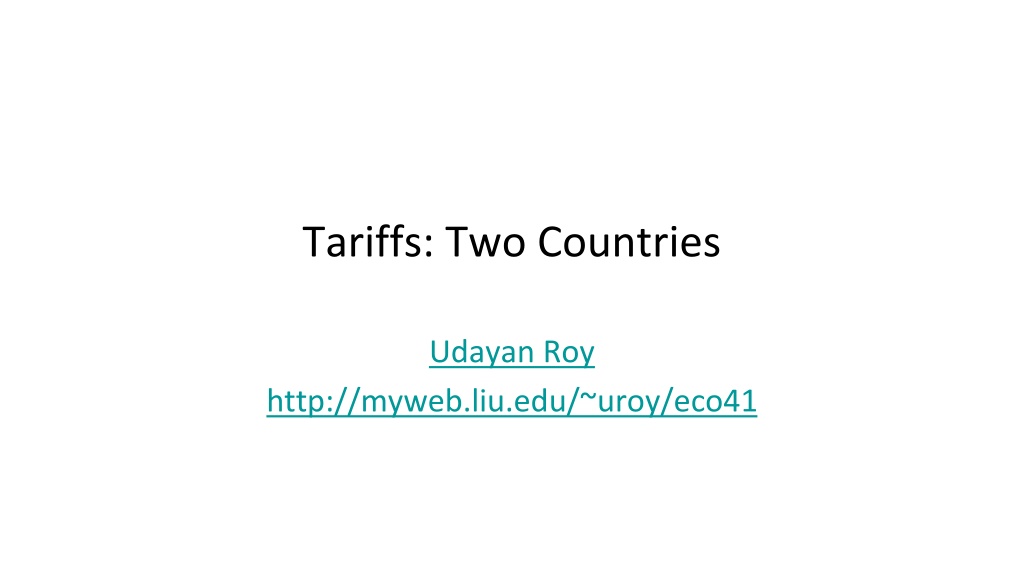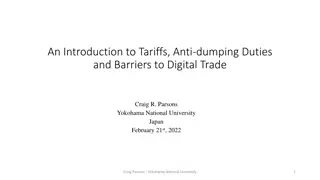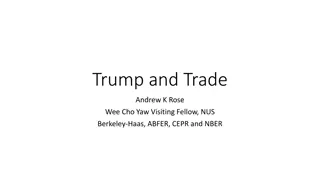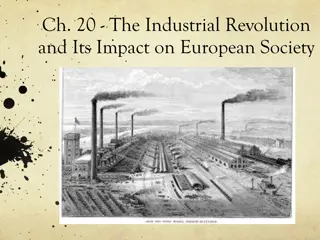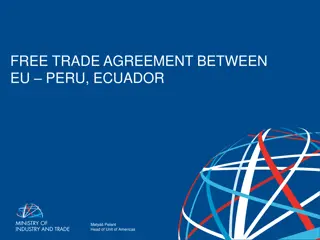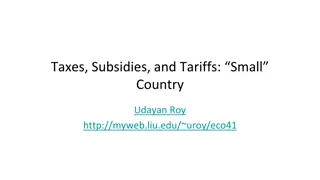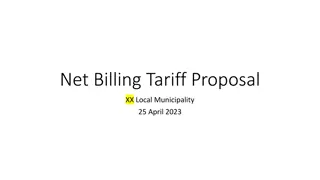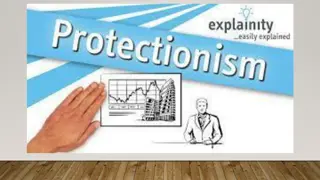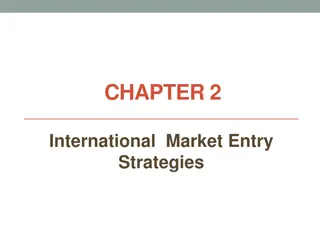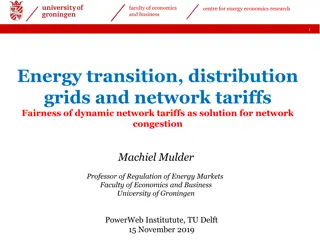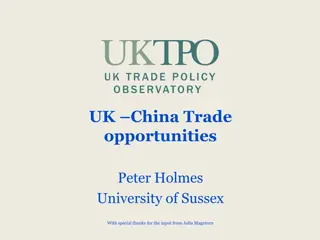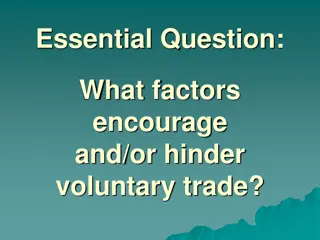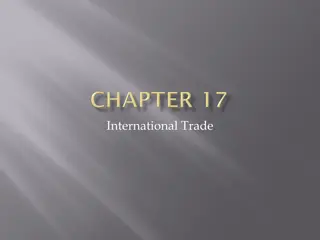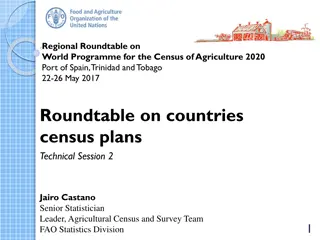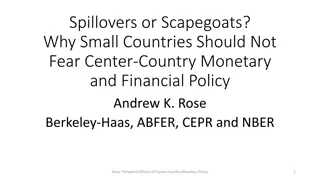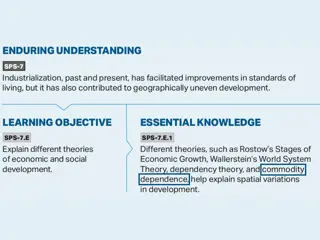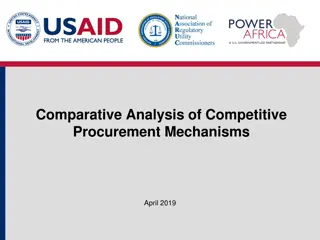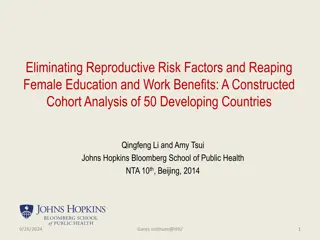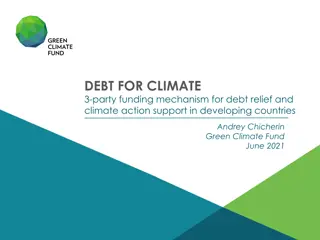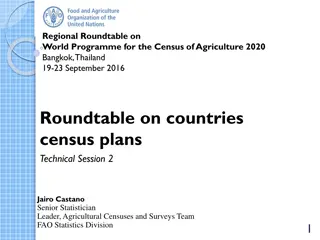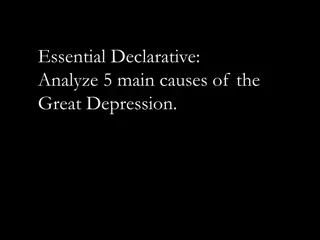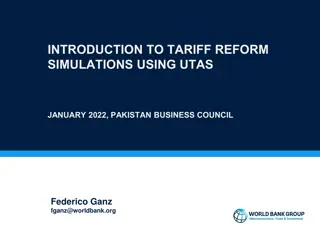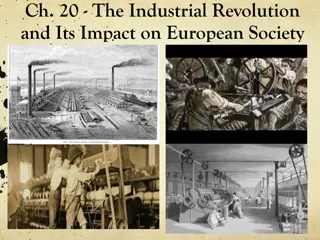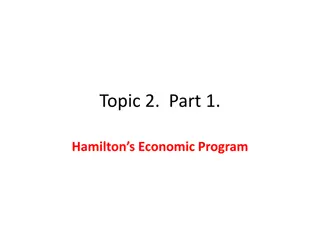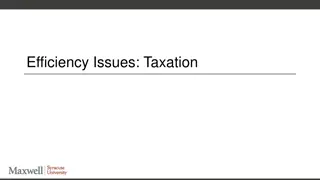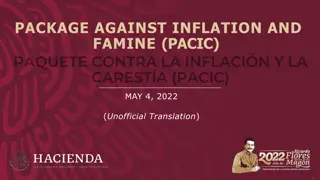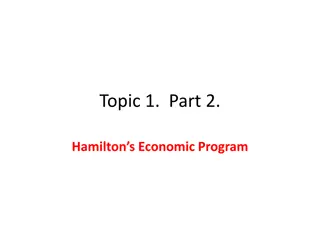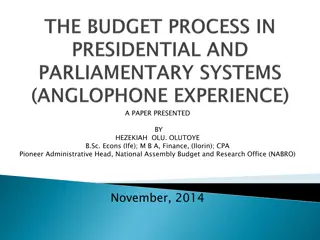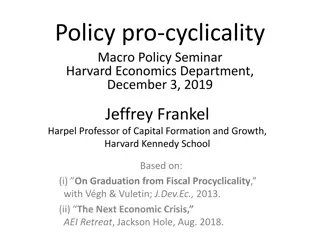The Impact of Tariffs: Analysis in Two Countries
Explore the detrimental effects of tariffs in small countries, including how they harm consumers, benefit local producers, and create deadweight losses. Compare the impact of tariffs, consumption taxes, and production subsidies, highlighting the disadvantages of tariffs. Discover why tariffs are considered the third-best option and how they can worsen the overall welfare of a two-country world.
Download Presentation

Please find below an Image/Link to download the presentation.
The content on the website is provided AS IS for your information and personal use only. It may not be sold, licensed, or shared on other websites without obtaining consent from the author. Download presentation by click this link. If you encounter any issues during the download, it is possible that the publisher has removed the file from their server.
E N D
Presentation Transcript
Tariffs: Two Countries Udayan Roy http://myweb.liu.edu/~uroy/eco41
Textbook Section Basic Tariff Analysis of Chapter 9 ( The Instruments of Trade Policy )
Recap: Tariffs are terrible for a small country We have seen in our analysis of the effects of a tariff in a small country that: Tariffs hurt consumers of imported goods Tariffs benefit producers of import-competing goods Tariffs provide revenue for the government The total costs exceed the total benefits That is, there are deadweight losses from tariffs
Recap: Tariffs are terrible for a small country We have also seen that: A tariff of, say, $5 per unit has the same effect as the joint use of a consumption tax of $5 per unit consumed and a production subsidy of $5 per unit produced domestically The consumption tax and the production subsidy are both damaging to national welfare The tariff combines the damaging aspects of the consumption tax and the production subsidy
Recap: Tariffs are terrible for a small country We have seen that: The production subsidy, though damaging to national welfare, is good for businesses A production subsidy alone is as good for businesses as a tariff but causes less damage than the tariff Because a tariff causes as much damage as a production subsidy and a consumption tax So, not only are tariffs worse than free trade, they are worse than a production subsidy Tariffs, therefore, are third best
Unlike a small country, a large country may theoretically be better off by imposing tariffs on its imports. But the other (exporting) country will be worse off by even more. So, the two-country world (as a whole) is made worse off by a tariff. TARIFFS IN A TWO-COUNTRY WORLD
Tariffs: Two-Countries Case For a country that is so large that events in the country can affect the worldwide prices of the goods it imports, the gains from a tariff may exceed the losses and the country as a whole may benefit from the tariff. In a two-country world, both are large countries However, the tariff will harm other countries more than the country that imposes the tariff may gain. So, the world, as a whole, will be harmed by the tariff.
Two-Country Free Trade There are two countries: Home and Foreign Autarky price of wheat is higher in Home So, under free trade, Home will import wheat from Foreign
Supply, Demand, and Trade in a Single Industry (1 of 4) In our example, Home imports wheat and Foreign exports wheat The amount that Home wishes to import will decrease as the price of wheat increases import demand curve; next slide
Supply, Demand, and Trade in a Single Industry (2 of 4) Home s import demand curve (MD) is the quantity that Home consumers demand (D) minus the quantity that Home producers supply (S), at each price: MD = D S.
Supply, Demand, and Trade in a Single Industry (1 of 4) In our example, Home imports wheat and Foreign exports wheat The amount that Foreign wishes to export will increase as the price of wheat increases export supply curve; next slide
Supply, Demand, and Trade in a Single Industry (3 of 4) Foreign s export supply curve (XS) is the quantity that Foreign producers supply (S*) minus the quantity that Foreign consumers demand (D*), at each price: XS = S* D*. Note: The Foreign country is indicated by an asterisk (*).
Supply, Demand, and Trade in a Single Industry For equilibrium in free trade between Home and Foreign, we assume: Home s import demand (MD) = Foreign s export supply (XS). Therefore, the equilibrium outcome under free trade between two countries is at the intersection of the import demand and export supply curves See next slide
Figure 9.3 World Free-Trade Equilibrium The equilibrium world price is PW, where Home import demand (MD curve) equals Foreign export supply (XS curve). The amount imported and exported is QW.
Prices after the tariff Now suppose Home imposes a tariff on the wheat it imports from Foreign. Then: Price in Home = Price in Foreign + Tariff imposed by Home For both imported and domestically-produced wheat (assuming some Foreign wheat continues to be imported into Home even after the tariff) Why?
Prices after the tariff Suppose the price of Foreign-made wheat in Foreign = 4 per ton Suppose the tariff imposed by Home on Foreign-made wheat = 2 per ton Then the price of Foreign-made wheat imported and sold in Home = 4 + 2 = 6 per ton Therefore, Home s wheat producers can t charge more than 6 in Home Because Home-made wheat is identical to Foreign-made wheat But can they charge less than 6? Can they charge, say, 5.40?
Prices after the tariff We have already seen that Home-made wheat cannot sell for more than the identical, imported Foreign-made wheat Can Home-made wheat sell for less than imported Foreign-made wheat? No. I have assumed that some Foreign-made wheat continues to be imported into Home even after the tariff. That could not have happened if Home-made wheat was selling for less than Foreign- made wheat Therefore, the price of Home-made wheat can be neither higher nor lower than imported Foreign-made wheat in Home Price in Home = Price in Foreign + Tariff imposed by Home
Equilibrium after the tariff After Home imposes a tariff, we must have: ?????= ????????+ Tariff : ??= ?? Home s import demand must equal Foreign s export supply: MD = XS. + ?
Effects of a Tariff (1 of 4) After Home imposes a tariff, we must have: ?????= ????????+ Tariff: ??= ?? Home s import demand must equal Foreign s export supply: MD = XS. + ? So, while the free trade outcome is shown by Point 1, the trade-under-tariff outcome is shown by two points: Point 2 and Point 3.
Effects of a Tariff (1 of 4) After Home imposes a tariff, we must have: ?????= ????????+ Tariff: ??= ?? Home s import demand must equal Foreign s export supply: MD = XS. + ? Free trade outcome is shown by Point 1. The price of wheat is PW in both countries, and the amount traded is QW. That is, Home imports the amount QW from Foreign, the exporting country.
Effects of a Tariff (1 of 4) After Home imposes a tariff, we must have: ?????= ????????+ Tariff: ??= ?? Home s import demand must equal Foreign s export supply: MD = XS. + ? The trade-under-tariff outcome is shown by Point 2 and Point 3. The price of wheat is PT in Home and PT* in Foreign. Note that PT = PT* + t (tariff). The amount traded is QT.
Effects of a Tariff (1 of 4) After Home imposes a tariff, we must have: ?????= ????????+ Tariff: ??= ?? Home s import demand must equal Foreign s export supply: MD = XS. + ? Compared to free trade, the tariff raises the price in the importing country but by less than the tariff. This is because the tariff reduces the price in the exporting country. Compared to free trade, the amount traded decreases.
As the size of the tariff increases, the quantity traded decreases. At some point the tariff is so large that all trade ceases. This is the so-called prohibitive tariff, shown by the red dots. The prohibitive tariff = ?? ?? importer s autarky price minus the exporter s autarky price. . This is the
Note that the tariff revenue is: zero when the tariff is zero, positive when the tariff becomes positive, and becomes zero again when the tariff is prohibitive. So, the tariff revenue is hump-shaped when plotted against the tariff rate. So, there is a tariff rate that maximizes tariff revenue.
Figure 9.4 Effects of a Tariff A tariff increases the price in Home (the importing country) and decreases the price in Foreign (the exporting country).
A B C M D F J E I G U K H N V O L R Home (Importer) Foreign (Exporter) Two-Country World Autarky Free Trade Tariff Autarky Free Trade Tariff Autarky Free Trade Tariff Consumer Surplus Producer Surplus Tariff Revenue Total Surplus
A B C M D F J E I G U K H N V O L R Home (Importer) Foreign (Exporter) Two-Country World Autarky Free Trade Tariff Autarky Free Trade Tariff Autarky Free Trade Tariff Consumer Surplus A ABCDEFG ABC MNO M MN AMNO ABCDEFGM ABCMN Producer Surplus BDHL HL DHL R NORUV ORV BDHLR HLNORUV DHLORV Tariff Revenue FJ FJ Total Surplus ABDHL ABCDEFGHL ABCDFHJL MNOR MNORUV MNO RV ABDHLMNOR ABCDEFGHLMNORUV ABCDFHJLMNORV
Gains and Losses from a Tariff: Importer Free Trade is better (that is, has higher total surplus) than autarky for both countries. When Home (the importer) imposes a tariff, it loses E and G but gains J (compared to free trade). If J > E + G, then the tariff may increase total surplus. Home (Importer) Foreign (Exporter) Two-Country World Autarky Free Trade Tariff Autarky Free Trade Tariff Autarky Free Trade Tariff Consumer Surplus A ABCDEFG ABC MNO M MN AMNO ABCDEFGM ABCMN Producer Surplus BDHL HL DHL R NORUV ORV BDHLR HLNORUV DHLORV Tariff Revenue FJ FJ Total Surplus ABDHL ABCDEFGHL ABCDFHJL MNOR MNORUV MNORV ABDHLMNOR ABCDEFGHLMNORUV ABCDFHJLMNORV
Gains and Losses from a Tariff: Exporter Foreign (the exporter) is worse off when Home (the importer) imposes a tariff. Foreign loses U when the tariff is imposed. Home (Importer) Foreign (Exporter) Two-Country World Autarky Free Trade Tariff Autarky Free Trade Tariff Autarky Free Trade Tariff Consumer Surplus A ABCDEFG ABC MNO M MN AMNO ABCDEFGM ABCMN Producer Surplus BDHL HL DHL R NORUV ORV BDHLR HLNORUV DHLORV Tariff Revenue FJ FJ Total Surplus ABDHL ABCDEFGHL ABCDFHJL MNOR MNORUV MNORV ABDHLMNOR ABCDEFGHLMNORUV ABCDFHJLMNORV
Gains and Losses from a Tariff: World So, as a result of the tariff, the World gains J and loses E + G + U in total surplus. It can be shown that J < U. (Can you see why?) Therefore, J < E + G + U. That is, the World s gains from the tariff are clearly smaller than the World s losses. Home (Importer) Foreign (Exporter) Two-Country World Autarky Free Trade Tariff Autarky Free Trade Tariff Autarky Free Trade Tariff Consumer Surplus A ABCDEFG ABC MNO M MN AMNO ABCDEFGM ABCMN Producer Surplus BDHL HL DHL R NORUV ORV BDHLR HLNORUV DHLORV Tariff Revenue FJ FJ Total Surplus ABDHL ABCDEFGHL ABCDFHJL MNOR MNORUV MNORV ABDHLMNOR ABCDEFGHLMNORUV ABCDFHJLMNORV
Gains and Losses from a Tariff: World Home may be better off or worse off if it uses a tariff. But Foreign is certainly worse off. And the damage to the exporter is bigger than any possible gains to the importer. The Two-Country World has lower total surplus from the tariff Home (Importer) Foreign (Exporter) Two-Country World Autarky Free Trade Tariff Autarky Free Trade Tariff Autarky Free Trade Tariff Consumer Surplus A ABCDEFG ABC MNO M MN AMNO ABCDEFGM ABCMN Producer Surplus BDHL HL DHL R NORUV ORV BDHLR HLNORUV DHLORV Tariff Revenue FJ FJ Total Surplus ABDHL ABCDEFGHL ABCDFHJL MNOR MNORUV MNORV ABDHLMNOR ABCDEFGHLMNORUV ABCDFHJLMNORV
A B C M D F J E I G U K H N V O L R
Gains and Losses from Tariffs: Importing Country The loss to the country that imposes the tariff (Home) includes E and G, which are the deadweight losses of a tariff that we saw even in the case of a small country that imposes a tariff on its imports. But in a two-country world, Home also gainsJ, which represents the improvement in its terms of trade. Had Home been a small country, it would not have been able to force a reduction in the price of its imported good. Therefore, tariffs would have had only losses and no gains.
Recap: Effects of TariffSmall Country Price of Steel Domestic supply A Deadweight Loss B Price Tariff with tariff C D E F Price World price G without tariff Imports after tariff Domestic demand QS QD QS QD Quantity of Steel 0 Imports without tariff
Effects of TariffLarge Country Price of Steel A large country can use tariffs to force down the price of its imported good. This leads to additional gain of E2. If E2 exceeds D+F, the country will be better off after imposing the tariff. Domestic supply A B Price Tariff with tariff C E1 D F World price before tariff E2 G Domestic demand World price after tariff QS QD QS QD Quantity of Steel 0 Imports without tariff
Retaliation The analysis so far has assumed that one country can impose tariffs on its imports without the other country retaliating with tariffs of its own If retaliation occurs, even the conditional support for tariffs outlined earlier has no basis
Textbook See the Costs and Benefits of a Tariff section of Chapter 9 ( The Instruments of Trade Policy ) of International Economics: Theory and Policy, 10th edition, by Paul Krugman, Maurice Obstfeld, and Marc Melitz. See especially Figures 9-9 and 9-10.
